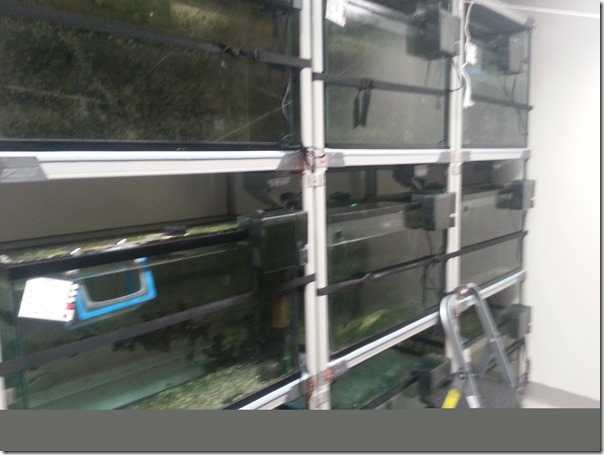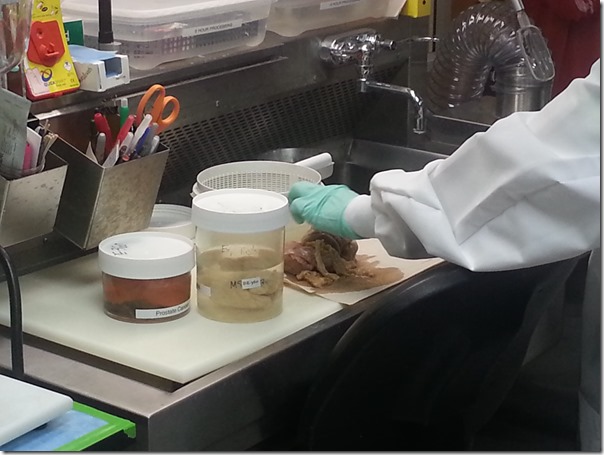Stickleback Tanks at Fred Hutchinson Cancer Research Center
Today, we started early at Fred Hutchinson Cancer Research Center, being a part of a research laboratory meeting. We had general conversations about the week at the start of the day, and learned about a really cool discovery that was discovered at Fred Hutchinson Cancer Research Center- tumor paint. This paint glows when exposed to a particular light. When paired with the correct binding materials, it will glow on a tumor. Part of the worries around cancer surgery is that some can be missed during the initial surgery. However, tumor paint changes this outcome. Also impressive was the 27 high school students part of research at the center.
Biological Specimens ready to be prepared for histology
Jesse Hubbard of the Torok-Storb Lab gave a talk about “Modeling MDS using iPSC.” iPSC means induced pluripotent stem cells, which would be taken to a patient, reprogrammed, and put back into a patient. Part of the great parts of stem cells is the fact that they are self-renewing. Jesse talked specifically about the p53 tumor suppressor gene, as well as a 5q- deletion found in MDS patients. They are hoping to move on to studying GATA 2 mutant and RUNX1 mutant iPSC models to further study the disease.
We then met with many different individuals who talked about their work- Dr. Beverly Torok- Staub, James Riddle, Brenda, including ethics and clinical trials, 3 spine sticklebacks and sex inheritance (they use a ZW system) and pathology and related histology jobs and the technology that is currently used to look at biological tissue.
We then went to the ISCRM which is made up of 50 research laboratories. The ISCRM is a collaboration among the University of Washington, Fred Hutchinson Cancer Research Center, Seattle Children’s Hospital, Institute for Systems Biology, Benaroya Research Institute, and Paul Allen Institute for Brain Science. The facility was beautiful and the 80,000 square foot facility was great for their purposes.
Dr. David Mack talked specifically about his research about myotubular myopathy. His research was very promising, using a dog model and eventually looking towards using in human clinical trials. Dr. Mack gave some bigger thoughts to think about, one of the most that was “Just because we can do something, should we?”
We then had a conversation with a couple of laboratory researchers about the ethics of using embryonic stem cells in research. I was interested in finding out that they go through around 100 embryos to be able to make one successful stem cell line. We went to the laboratory and looked at stem cells under the microscope.
We ended the day looking at Dr. Chuck Murry’s work with the heart. He gave us a seminar about how heart attacks are the number one killer worldwide, blaming the culture shift from malnourished to an excess of food. The heart has a stored ATP supply of about 1 minute. It takes about 15 minutes before cell death happens in the heart, but many people do not come in during this time period- leading to a lot of cardiac damage.
Dr. Murry is looking at using stem cells as an intervention to stop the scarring that happens after a heart attack. They use different growth factors to differentiate “beaters”- heart cells in a dish. They’ve done experiments with 1000’s of rats, 100’s of mice, and 100’s of guinea pigs. The issue with this therapy is the immune system recognizes the tissue as foreign, so a person would have to take immunosupressants…but that beats death.

